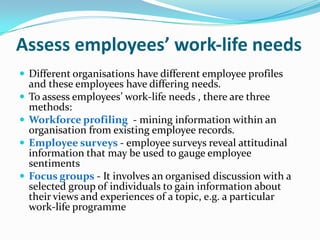Work life integration
- 1. Work Life Integration Dr. G C Mohanta, BE(Mech), MSc(Engg), MBA, PhD(Mgt) Professor Al-Qurmoshi Institute of Business Management, Hyderabad - 500005
- 2. Work‐life Integration Work‐life Integration is an outcome of people exercising control & choice in their life to meet life’s challenges This can be managing work responsibilities alongside their personal & family needs. The areas of a person’s life which require integration will change based on the individual’s life stages A person in his or her 20s may be balancing career development and social activities In 30s, when a person gets married & starts a family, family & job responsibilities become competing challenges
- 3. Why Work-Life Integration Is Important? Work & life stressors will continue to increase, as expectations & choices compel us to seek for what is a “good life”. Our core values & life goals become the skill‐set that enables us in work‐life balancing and in living & working efficiently and effectively. When organisation takes cognizance of this work‐life imperative and designs a conducive work environment, it motivates the employees to work more efficiently and productively.
- 4. What are the roles of stakeholders? To implement a successful Work‐life Strategy, the organisation, supervisors and employees all need to play their parts. Work‐life programmes succeed in organisations where there is a workplace culture based on reciprocity & trust The work‐life integration responsibilities are shared among the organisation, supervisors and employees.
- 5. Role organisation The organisation develops and communicates a Work‐life Strategy suitable for its business and its employees makes its work‐life programmes available to as many of its employees as possible, has a sound performance management system that allows it to evaluate all its employees objectively and trains its supervisors to support Work‐life Strategy.
- 6. Role of Supervisors The supervisors support the organisation’s Work‐life Strategy; help tailor an employee’s flexible work arrangements in consultation with the employee and other relevant departments in the organisation, evaluate employee performance by outcomes and deliverables rather than hours clocked and physical presence in the office.
- 7. Role of Employees The employees familiarise themselves with the organisation’s work‐life programmes and makes use of them appropriately; work with their immediate supervisors to design flexible work arrangements and other work‐life programmes that do not compromise business outcomes; and engage themselves in their work and add value to the organisation throughout their period of employment.
- 8. Four steps to a successful Work‐life Strategy
- 9. Establish need to implement Work-Life Integration Organisations implement work‐life programmes for one or more of the following reasons: Attract and/or retain talent Raise morale Increase productivity Save on real estate and overhead expenses Reduce healthcare costs Provide work flexibility in response to changing employee needs Increase commitment Combat burnout Be an Employer of Choice Stay ahead of the competition
- 10. Assess business needs Business needs include corporate values, objectives and operational standards that cannot be compromised for any reason. If a business revolves around customer-facing services (e.g. in a retail outlet) it may be possible to implement flexi-time with some creative scheduling On the other hand, if there is a need for 24-hour operations (e.g. in a hospital), rotating 12-hour shifts with more days off might be appropriate, but a flexi- time would not.
- 11. Assess employees’ work‐life needs Different organisations have different employee profiles and these employees have differing needs. To assess employees’ work-life needs , there are three methods: Workforce profiling - mining information within an organisation from existing employee records. Employee surveys - employee surveys reveal attitudinal information that may be used to gauge employee sentiments Focus groups - It involves an organised discussion with a selected group of individuals to gain information about their views and experiences of a topic, e.g. a particular work-life programme
- 12. Designing Work‐Life Programmes Flexible Work Arrangements (FWA) - An effective FWA takes into account the nature of the employee’s job and his/her requirements Leave Benefits - annual leave, childcare leave, maternity leave and sick leave Employee Support Schemes - dependent care support, health and wellness programmes, flexible benefits and time-saving services Companies that already provide a service as a business could extend it to their employees at marginal cost, e.g. transportation, laundry, childcare, etc.
- 13. Implementing Work‐Life Programmes Develop a communication plan - Successful implementation of work-life programmes hinges on proper communication of the programmes to employees Employees need to be aware of work-life programmes to reap its benefits, thereby improving employee engagement & turnover. Senior management support - Support from senior management for Work-life Strategy, will make employees feel comfortable in supporting, participating and using the work-life programmes. Clear policies and guidelines - Work-life programmes need to be supported by clear policies & guidelines to address the values, eligibility criteria & operational details of the programmes
- 14. Evaluating Work‐Life Programmes Measuring the effectiveness of work-life programmes allows us to determine whether we have met the objectives. The following are evaluated in Work-Life Programmes: - Utilisation rate of the work-life programmes - Absenteeism - Employee job satisfaction, engagement, etc. - Turnover rate - Feedback from employees about the work-life programme in meeting their needs - Feedback from supervisors on difficulties faced in implementing work-life programmes - Feedback from exit interviews














